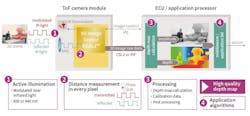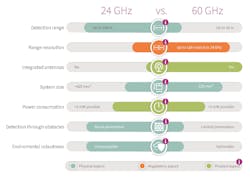Check out our Sensors Converge 2023 coverage.
What you will learn:
- Why range-sensing applications are becoming more common.
- What’s the difference between radar and optical sensing?
- Why these sensors are better than using passive-infrared (PIR) technology.
Anyone remember when radar and optical time-of-flight (ToF) sensors were very expensive, hard to design in, and so on? It wasn’t that long ago and the thought of using them in consumer and commercial applications, other than specialized applications like avionics and automotive, was considered fantasy land.
But not anymore. Kim Lee, Senior Director of Systems Applications Engineering for Sensors, Solutions and IoT at Infineon Technologies Americas, shows some demos of these technologies in the video (watch the video above).
While passive-infrared (PIR) technology has been the go-to solution for low-cost motion detection applications, it has severe limitations when it comes to providing more information than just a presence indication. Alternatives like radar and optical time-of-flight (ToF) sensors provide significantly more accurate and detailed information, yet the cost and complexity of the systems used to be significantly higher and thus prohibitive.
These days, ToF and radar sensors are not only economical for many applications, but they provide 3D sensing capabilities like Infineon’s Real3 3D image sensors (Fig. 1). The REAL3 3D ToF sensors work with infrared illumination so that the system will work in the dark. It utilizes 850- or 940-nm infrared sources.
Infineon’s XENSIV 24- and 60-GHz radar sensors target industrial, commercial, and consumer applications (Fig. 2). They can include fully integrated microwave radar motion sensors with antennas-in-package (AIP) that are capable of detecting motion and the direction of motion. The systems consume as little as 5 mW.
The company also has solutions that target other markets, such as rugged and automotive applications. Some of the products mentioned above that are aimed at the industrial and consumer space may also find their way into rugged and automotive spaces, performing operations such as tracking drivers and occupants.
Furthermore, 3D sensors can provide additional functionality like gesture detection. This is often done by the host processor using incoming depth map frames. These have the advantage over video sensors from a privacy standpoint because there’s no video information to record.
Check out more of our Sensors Converge 2023 coverage.


